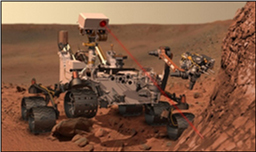Utility’s Commitment to Technology and Innovation Boosts Safety and
Job Growth
SAN FRANCISCO--(BUSINESS WIRE)--
Pacific Gas and Electric Company (PG&E) helped to advance natural gas
industry safety by testing and deploying more than 30 new, innovative
gas safety tools in 2014. Thanks in large part to PG&E’s Gas Operations
Research and Development team, the California utility is working with
other forward-thinking companies, research institutions and government
agencies to create the next generation of safety tools for natural gas
pipeline operators which also supports a variety of high-tech jobs
within the sector.

In this image, the methane gas detector device is at work on Mars (artist's concept). The device is housed inside the main Rover compartment and is used to analyze gas samples. Image Credit: NASA/JPL-Caltech
The new technologies are helping transform utilities into more
predictive and proactive operators and aid in providing detailed
inspections, often in less time with greater accuracy and precision than
traditional methods. Examples of these technologies being deployed by
the company include:
-
3D
Toolbox: This year, PG&E deployed a specialized tool that
captures a three-dimensional image of a pipe that identifies and
measures dents, cracks or corrosion on the outer surface so that it
can be analyzed and repaired before it becomes a potential safety
issue.
-
Mars
Rover Technology for Gas-Leak Detection: In collaboration with
NASA’s Jet Propulsion Laboratory, PG&E adapted and tested laser-based
technology—originally designed to find methane on Mars—to locate
natural gas leaks on Earth more effectively than traditional methods.
-
Inspection Robots: PG&E tested and implemented a variety of gas
pipeline inspection robots in 2014. In early 2014, PG&E launched a
customized “smart-pig”
that travels inside transmission pipelines and captures detailed
information about the inside of the pipe without any interruption to
gas service. Later in the year, the company tested a miniature
robot to inspect the outer portion of a pipe inserted in pipes
casings without digging the ground above.
“Working alongside some of the best scientific minds in the world, we’re
developing new predictive capabilities about natural gas operations with
the intelligence gathered by these tools,” said Sumeet Singh, vice
president gas operations asset and risk management. “We’ve been able to
make advancements in advancing natural gas pipeline safety through
innovation and we are committed to not only continuing to enhance the
safety of our system, but also sharing such solutions across the
industry.”
PG&E expects that many of these tested technologies will become
commercially available in 2015.
About PG&E
Pacific Gas and Electric Company, a subsidiary of PG&E
Corporation (NYSE:PCG), is one of the largest combined natural gas
and electric utilities in the United States. Based in San Francisco,
with more than 20,000 employees, the company delivers some of the
nation’s cleanest energy to nearly 16 million people in Northern and
Central California. For more information, visit www.pge.com/
and www.pge.com/en/about/newsroom/index.page.
http://www.pgecurrents.com/
http://www.facebook.com/pacificgasandelectric
https://twitter.com/pge4me
http://www.linkedin.com/company/pacific-gas-and-electric-company
http://www.youtube.com/user/pgevideo

Photos/Multimedia Gallery Available: http://www.businesswire.com/multimedia/home/20150102005443/en/
Source: Pacific Gas and Electric Company